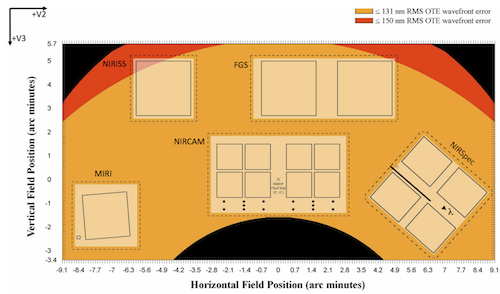JWST Home - JWST NIRSpec
ESA and the James Webb Space Telescope |
|
The James Webb Space Telescope (JWST) is a collaborative project between NASA, ESA, and the Canadian Space Agency (CSA). Although radically different in design, and emphasizing the infrared part of the electromagnetic spectrum, JWST is widely seen as the successor to the Hubble Space Telescope (HST).
 The focal plane of the JWST telescope with the assigned field of views for the instruments.
The JWST observatory will consist of a deployable 6.6 meter passively cooled telescope optimized for infrared wavelengths, and will be operated in deep space at the anti-Sun Earth-Sun Lagrangian point (L2). It will carry four scientific instruments: a near-infrared camera (NIRCam), a near-infrared multi-object spectrograph (NIRSpec) covering the 0.6 - 5 μm spectral region, a near-infrared slit-less spectrograph (NIRISS), and a combined mid-infrared camera/spectrograph (MIRI) covering 5 - 28 μm. The JWST focal plane (see image to the right) contains apertures for the science instruments and the Fine Guidance Sensor (FGS).
The scientific goals of the JWST mission can be sorted into four broad themes:
Although the first two of these themes are extragalactic in nature and concerned with exploring the formation of stars and galaxies in the remote Universe at the earliest times, they are intimately linked to the latter two mainly galactic themes, which aim at understanding the detailed process of star and planet formation in our own galaxy.
 Images of the Flight Models of NIRSpec (top left) and MIRI (bottom left). The drawing on the right depicts JWST folded up in the Ariane 5 launcher.
The European Space Agency is responsible for providing NIRSpec from ESA funds, and approximately half of MIRI through special contributions from the member states via a consortium of European science institutions (EC). As its non-instrument contribution, ESA will provide the Ariane 5 launcher that will place the JWST observatory in its orbit around L2. Furthermore, a number of ESA staff will be posted at the Space Telescope Science Institute (STScI) in Baltimore in support of the European payload components as ESA's contribution to JWST operations.
The purpose of this web-site is to provide information specific to the NIRSpec instrument, its performances and calibration. Designed as a multi-object spectrograph (MOS), NIRSpec will be able to observe more than 100 astronomical objects simultaneously. It has a large field of view (≈ 3' × 3') and is highly sensitive over its wavelength range (0.6 to 5 μm). The purpose of NIRSpec is to provide low (R~100), medium (R~1000), and high-resolution (R~2700) spectroscopic observations in support of the four main science themes of JWST. NIRSpec is developed by ESA with EADS Astrium Germany GmbH as the prime contractor.
If you are looking for more general information on the JWST mission and its science, please be referred to the following websites:
|
- Removed a total of (1) style text-align:center;
- Removed a total of (1) style text-align:justify;
- Removed a total of (2) style font-weight:bold;
- Removed a total of (2) style float:right;
- Removed a total of (1) align=left.
- Removed a total of (1) border attribute.








































 Sign in
Sign in
 Science & Technology
Science & Technology